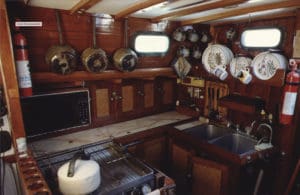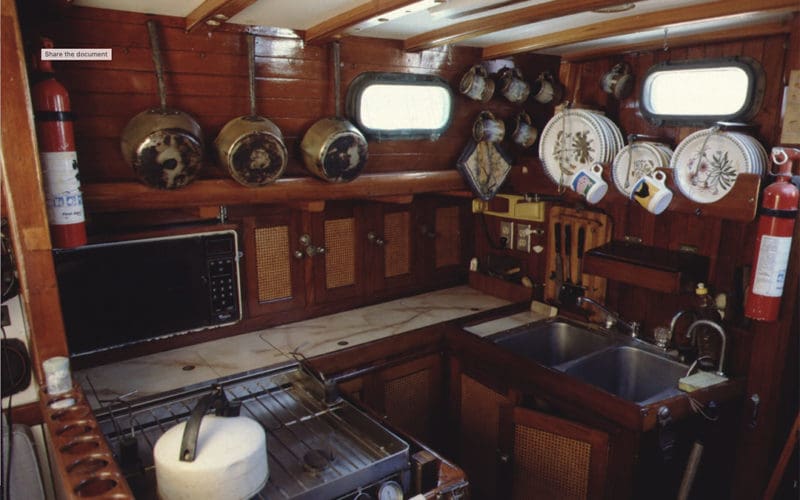
The most memorable boat meal for me was in Brightlingsea, on the east coast of England. My elder brother, Chris, the owner of an old wooden boat named Wallop, was romancing a girl. After a leisurely sail, we anchored and I was decidedly in the way.
I took myself off to the cockpit to fish, using a line with multiple hooks. I caught a good-sized eel, creating a terrible tangle of hooks and monofilament and wriggling fish. To subdue the eel, I cut off its head. Unfortunately blood pulsed forth, all over the girlfriend. The eel finally stopped convulsing. We decided to fry it on Wallop’s gimballed primus stove. When we dropped it in the hot pan, headless as it was, it came back to life, twisting violently from side to side and threatening to come clean out of the pan. I don’t believe that romance went anywhere.
When it came to building my first cruising boat, I read all the available books and was persuaded by Hal Roth (author of After 50,000 Miles) to buy an expensive diesel stove with a cast iron top. In use it took a while to warm up, but eventually the entire top rose to cooking temperatures. What a disaster that was! Hal was from the (chilly) Pacific Northwest, while we were headed to the tropics.
We set sail from New Orleans to Key West with one year old Pippin who was already ambulatory. Whenever the stove was lit, we had to watch her like a hawk to make sure she didn’t touch the top and burn herself. The stove rarely got used and was a constant source of arguments between my wife, Terrie, and me.
I ripped the stove out in Key West, rented a car, and took it to the Sailorman consignment store in Fort Lauderdale, looking for a substitute. This was in 1987. Last time I checked, about 10 years later, our stove was still there, relegated to a high shelf. The obvious choice to replace it was propane, but having been badly burned in a natural gas explosion on an oil rig a few years earlier (I bear the scars to this day, and was lucky to escape alive) I was determined not to have any form of gas on board. I bought a second hand, two-burner kerosene stove with oven, also from Sailorman.
You had to prime the burners with alcohol to get them going. Within a week, Pippin had stuck her hand in the priming cup and badly burned two fingers.
Kerosene stoves work well so long as they are supplied with spotlessly clean, low-carbon-content, fuel. We sailed as far as Venezuela before our kerosene supply ran out. We had no trouble replenishing it, but clearly this was a low grade of kerosene. Our burners began to carbon up and fail. I was having to dismantle them and clean them every week, and then every day, and then just to boil enough water for a cup of tea, and finally there was no tea. We returned to Florida and removed the kerosene stove.
I had had 10 years to get over my fear of gas. In addition to which, I now knew enough to realize that a properly-installed gas stove creates a minimal fire or explosion risk. We bought a brand new Force 10 propane stove and connected it to a gas locker constructed to comply with ABYC standards. It was wonderful!
It had been a long and frustrating voyage around the onboard culinary options. In our wake I had left a trail of broken and discarded stoves and stove parts, thrown away a great deal of money, wasted countless hours setting up the different systems, and had numerous arguments with Terrie!
Since them we have commissioned three more boats. Each has had a Force 10 propane stove, with evolutionary improvements from one model to the next.
Over the past decade or so I have conducted extensive hybrid and other testing. One of the byproducts has been a super efficient eight kilowatt alternator (the Integrel system) coupled to a substantial bank of lithium-ion batteries.
I have not been able to break the system so I’d like to remove the propane from the boat and instead go all electric with an induction stove top and gimballed electric oven. Unfortunately, Terrie has come to like cooking on gas, and given that the limit of my culinary expertise is heating up beans, I am in no position to argue. Well, except that I am pretty good with fried eels. ν
Ocean Navigator contributing editor Nigel Calder is the author of the bestselling Boatowner’s Mechanical and Electric Manual among many other well-known marine books.

